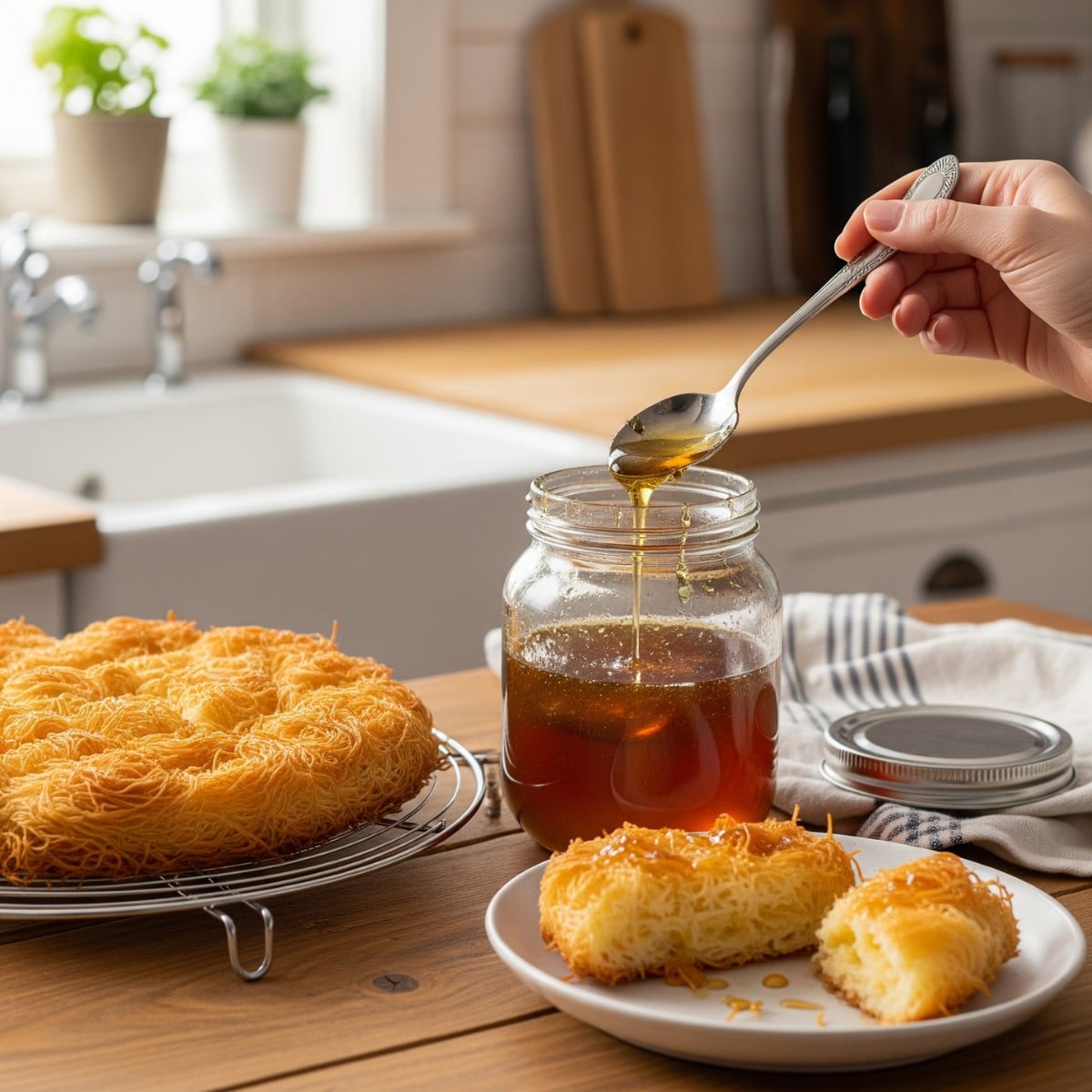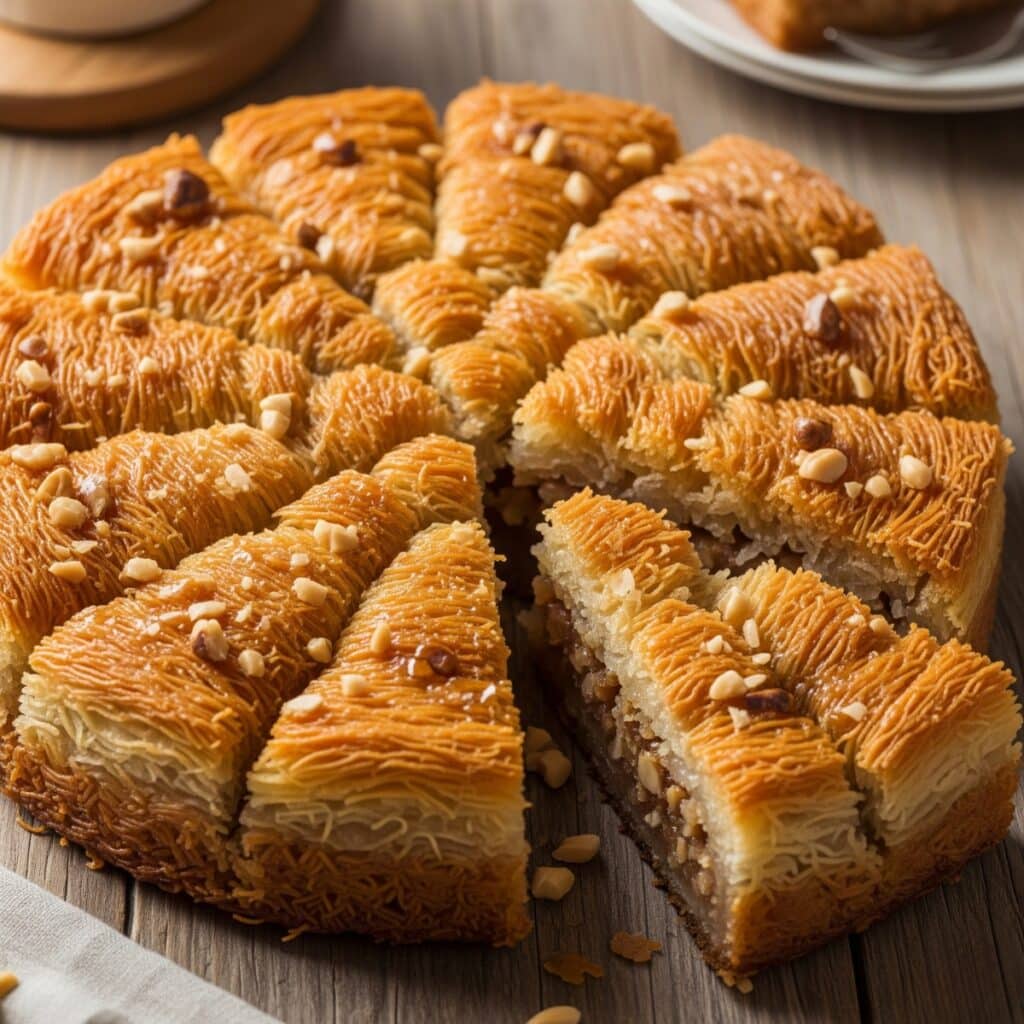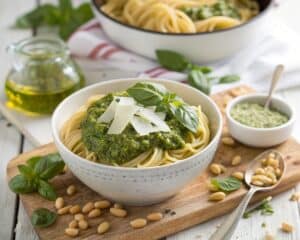Introduction
If you’re a fan of rich, flaky sweets with a touch of Mediterranean magic, you’ve probably heard of Greek desserts kataifi. This delightful treat, made from delicate shredded pastry soaked in sweet syrup, is a beloved classic that brings a little bit of Greece to your kitchen.
Here at RecipeYZ, I’m excited to share this recipe with you, breaking it down step-by-step so you can bring this traditional Greek dessert to your table without the fuss. Kataifi’s unique texture and sweet, nutty filling make it a standout among traditional Greek desserts and a perfect way to impress family and friends at your next gathering.
Print
Greek Desserts Kataifi
- Total Time: 1 hour 10 minutes
- Yield: 8 servings 1x
Description
If you’re a fan of rich, flaky sweets with a touch of Mediterranean magic, you’ve probably heard of Greek desserts kataifi. This delightful treat, made from delicate shredded pastry soaked in sweet syrup, is a beloved classic that brings a little bit of Greece to your kitchen.
Ingredients
- 1 lb (450g) kataifi pastry
- 1 cup (225g) unsalted butter
- 2 cups (200g) chopped nuts (walnuts, pistachios, almonds)
- 1 tsp ground cinnamon
- 1 cup (200g) sugar
- 1 cup (240ml) water
- 2 tbsp lemon juice
- 2 tbsp honey
Instructions
- Finely chop nuts and mix with ground cinnamon.
- Carefully separate the kataifi pastry strands to avoid clumping.
- Melt butter and grease a baking dish generously.
- Place a handful of kataifi loosely in the dish and brush with melted butter.
- Sprinkle a layer of nut mixture evenly over the pastry.
- Repeat layering kataifi and nuts, finishing with kataifi on top and brushing with butter.
- Preheat oven to 350°F (175°C) and bake for 45-50 minutes until golden and crisp.
- While baking, combine sugar, water, lemon juice, and honey in a saucepan; boil then simmer 10 minutes until slightly thickened; cool to room temperature.
- Pour cooled syrup evenly over hot kataifi immediately after baking.
- Let soak for at least an hour before serving.
Notes
Use fresh, high-quality kataifi pastry and nuts. Pour cooled syrup over hot pastry to maintain crispness. Store leftovers in an airtight container at room temperature for up to 3 days.
- Prep Time: 20 minutes
- Cook Time: 50 minutes
- Category: Dessert
- Method: Baking
- Cuisine: Greek
Nutrition
- Serving Size: 1 piece
- Calories: 350
- Sugar: 30g
- Sodium: 50mg
- Fat: 22g
- Saturated Fat: 10g
- Unsaturated Fat: 12g
- Trans Fat: 0g
- Carbohydrates: 30g
- Fiber: 2g
- Protein: 5g
- Cholesterol: 35mg
Table of Contents
Understanding Greek Desserts Kataifi
What is kataifi made of?
Kataifi is made from a special type of pastry that looks like shredded wheat or fine vermicelli noodles. This pastry, known as kataifi dough or shredded phyllo, is the base for the dessert. It’s typically filled with a mixture of chopped nuts—often walnuts, almonds, or pistachios—and flavored with warm spices like cinnamon and cloves. After baking, greek desserts kataifi is drenched in a fragrant syrup made from sugar, water, and lemon juice or honey, giving it that signature sticky sweetness that keeps you coming back for more.
The history and cultural significance of kataifi in Greece
greek desserts kataifi has a rich history rooted in the Eastern Mediterranean and Middle Eastern culinary traditions, where shredded pastry sweets have been enjoyed for centuries. In Greece, kataifi has become a staple dessert, especially during holidays and celebrations. It’s more than just a treat; it’s a symbol of hospitality and tradition, often prepared in family kitchens and served to guests as a gesture of warmth and generosity.
How greek desserts kataifi fits into the broader world of Greek desserts
While kataifi shares the spotlight with other Greek favorites like baklava and galaktoboureko, it stands out for its unique texture and preparation. It belongs to a family of syrup-soaked desserts that marry crisp pastry and sweet, nutty fillings. For those interested in discovering more about Greek dessert variations, greek desserts kataifi offers a delightful twist with its delicate shredded dough, making it a must-try for any dessert lover exploring traditional Greek sweets.
Kataifi vs. Other Classic Greek Desserts
What is the difference between baklava and kataifi?
When exploring Greek desserts kataifi, one common question is how it compares to baklava. Both are famous syrup-soaked treats featuring nuts and phyllo pastry, but the main difference lies in the type of dough used. Baklava uses layered sheets of thin phyllo, creating a rich, flaky texture, whereas kataifi uses shredded phyllo dough that resembles fine threads. This shredded pastry gives kataifi a unique, crunchy texture that sets it apart from other kataifi recipe often gets grouped with, like baklava.
How kataifi stands out in texture and flavor
Greek desserts kataifi is prized for its distinct shredded texture that crisps up beautifully when baked. The crunchy exterior contrasts with the sweet, nutty filling inside, soaked in a fragrant syrup. This balance of textures and the syrup’s sticky sweetness make kataifi a standout among recipe for kataifi lovers can’t resist.
Other famous Greek desserts kataifi fans should know
If you’re delving into Greek desserts kataifi style, you might also want to try other classics like galaktoboureko—a creamy custard-filled phyllo dessert—and loukoumades, which are sweet, honey-drenched doughnuts. These desserts, like kataifi, showcase the rich tradition of syrup-soaked sweets in Greek cuisine. For more inspiration, check out the collection of traditional Greek desserts on RecipeYZ.
Ingredients and Preparation Basics for Homemade Kataifi recipe

Key ingredients used in making Greek desserts kataifi
To make authentic Greek desserts kataifi, the ingredients are simple but essential. The star is the kataifi pastry—a special shredded phyllo dough that forms the crispy layers of this dessert. For the filling, chopped nuts like walnuts, pistachios, or almonds are traditional, adding a rich texture and flavor that Greek desserts kataifi fans love. Butter, cinnamon, sugar, and a touch of honey or lemon juice complete the ingredient list, giving the dessert its sweet, aromatic character.
Sweet syrups and nuts commonly used in Homemade Kataifi recipe
The syrup in Greek desserts kataifi is a crucial element that ties all the flavors together. Made from sugar, water, lemon juice, and sometimes honey, this syrup soaks into the shredded pastry, creating that signature sticky sweetness. Using fresh, high-quality nuts like pistachios or walnuts enhances the nutty flavor that makes Homemade Kataifi recipe so irresistible. You can even experiment with adding orange zest or a pinch of cloves to the syrup for a personalized twist.
Tips for selecting the best ingredients for Greek desserts kataifi
Choosing the freshest kataifi pastry is key to perfect Homemade Kataifi recipe. Look for tightly packed, well-frozen shredded phyllo with no signs of freezer burn. Fresh nuts should be chopped just before use to maximize flavor and crunch. The quality of your butter and honey will also impact the final taste, so opt for unsalted butter and pure honey. Using the best ingredients ensures your Greek desserts kataifi come out golden, flavorful, and absolutely delicious.
For more tips on selecting quality ingredients, check out related recipes like Greek yogurt recipes that also focus on fresh, wholesome components.
Step-by-Step greek desserts kataifi Recipe for Home Cooks
Ingredients You’ll Need
| Ingredient | Amount |
|---|---|
| Kataifi pastry | 1 lb (450g) |
| Unsalted butter | 1 cup (225g) |
| Chopped nuts (walnuts, pistachios, almonds) | 2 cups (200g) |
| Ground cinnamon | 1 tsp |
| Sugar | 1 cup (200g) |
| Water | 1 cup (240ml) |
| Lemon juice | 2 tbsp |
| Honey | 2 tbsp |

Step 1: Prepare the Nuts and Pastry
Start by finely chopping your nuts and mixing them with the ground cinnamon. Carefully separate the greek desserts kataifi pastry strands to avoid clumping. This step can be a bit messy, but patience here will give you that beautiful flaky texture.
Step 2: Layer the Kataifi
Melt the butter and keep it warm. Grease your baking dish generously with butter. Take a handful of kataifi, spread it loosely in the dish, and brush with melted butter. Sprinkle a layer of the nut mixture evenly over the pastry. Repeat layering Homemade Kataifi recipe and nuts, finishing with a kataifi layer on top, generously brushing with butter.
Step 3: Bake to Golden Perfection
Preheat your oven to 350°F (175°C). Bake the kataifi for 45-50 minutes until the top is golden and crisp. The smell during baking is irresistible—a warm, nutty invitation to your kitchen.
Step 4: Make the Syrup
While the greek desserts kataifi is baking, combine sugar, water, lemon juice, and honey in a saucepan. Bring to a boil, then simmer for about 10 minutes until it thickens slightly. Let it cool to room temperature.
Step 5: Pour Syrup and Serve
Once the greek desserts kataifi is out of the oven, immediately pour the cooled syrup evenly over the hot pastry. Let it soak for at least an hour before serving so the syrup infuses the layers beautifully.
Personal Anecdote
This recipe became my go-to dessert for family gatherings after my kids fell in love with its crunchy-sweet charm. It’s always a hit, and honestly, I’m pretty sure the syrup alone could win awards!
Serving Suggestions and Variations
How to serve kataifi for family and guests
The kataifi is best enjoyed fresh and at room temperature, allowing the syrup to fully soak into the shredded pastry. Serve it on a pretty dessert plate, maybe with a sprinkle of extra chopped pistachios or a light dusting of powdered sugar for an elegant touch. It pairs wonderfully with a cup of strong Greek coffee or a glass of sweet dessert wine, making it a perfect finish to any meal or festive gathering.
Popular variations of Greek Kataifi
One of the joys of kataifi is its versatility. You can switch up the nut filling by using different nuts such as pecans or hazelnuts, depending on your preference or what you have on hand. For a creamier twist, try adding a layer of clotted cream or mascarpone between the layers of pastry and nuts. Some variations also include a touch of orange zest or rose water in the syrup for a fragrant, floral note. These small changes can make the dessert feel fresh and personalized every time.
Pairing greek desserts kataifi with beverages or other dishes
To complement Greek Kataifi’s sweet, nutty flavor, consider pairing it with lighter Greek dishes like a fresh salad or grilled meats for a balanced meal. It also goes great with other traditional desserts, such as galaktoboureko, creating a dessert spread that showcases the best of Greek sweets. For drinks, a hot herbal tea, Greek coffee, or even a sweet Muscat wine will round out the experience beautifully.
Tips for Making and Storing Kataifi Desserts

Practical tips for handling kataifi pastry
Handling cripsy kataifi pastry can feel intimidating at first because of its delicate, shredded texture. The key is to keep it covered with a damp towel while working to prevent it from drying out. When separating the strands, gently loosen them with your fingers rather than pulling aggressively. Brushing each layer generously with melted butter helps achieve that perfect golden crunch and prevents the pastry from sticking together.
How to store kataifi to keep it fresh
Kataifi is best enjoyed within 2-3 days of baking for the freshest taste and texture. Store any leftovers in an airtight container at room temperature if you plan to eat them quickly. For longer storage, refrigerate the cripsy kataifi, but be aware that the syrup might make the pastry a bit softer. To revive some crispness, you can reheat the dessert in a low oven for a few minutes before serving.
Troubleshooting common Homemade Kataifi recipe making issues
If your kataifi turns out soggy, it’s usually due to pouring too much syrup or pouring it while the syrup is still hot. Always pour cooled syrup over hot Homemade Kataifi recipe to keep the pastry crisp but soaked. On the flip side, if the kataifi is too dry or hard, you might not have brushed enough butter or syrup. Remember, the balance of butter and syrup is what makes this dessert irresistible.
FAQs About Greek Desserts Kataifi
What is kataifi made of?
Kataifi is made from shredded phyllo dough, which resembles thin, delicate threads or shredded wheat. This pastry is combined with a filling of chopped nuts—usually walnuts, pistachios, or almonds—and flavored with warm spices like cinnamon. After baking, it’s soaked in a sweet syrup made from sugar, water, lemon juice, and sometimes honey, giving it its signature sticky sweetness.
What is the difference between baklava and kataifi?
The main difference between baklava and kataifi lies in the type of pastry used. Baklava uses layered sheets of thin phyllo dough, creating a flaky, buttery texture, while kataifi uses shredded phyllo dough, which produces a lighter, stringy, and crisp texture. Both are soaked in sweet syrup and filled with nuts, but the texture and appearance set them apart.
What is kataifi Greek to English?
In English, “kataifi” refers to this special shredded phyllo pastry used in desserts. The word itself comes from Greek, describing the unique, thread-like dough that forms the base of the dessert known internationally as kataifi.
What is a famous Greek dessert?
Greece is known for many delicious desserts, but some of the most famous include baklava, kataifi, and galaktoboureko—a creamy custard-filled phyllo pastry. Each of these sweets highlights the rich tradition of syrup-soaked pastries that are central to Greek cuisine. You can explore more traditional Greek desserts on RecipeYZ to find your new favorite.
Conclusion
Greek desserts kataifi bring a wonderful mix of tradition, texture, and sweet, nutty flavor to any dessert table. This shredded pastry treat is surprisingly approachable for home cooks, yet impressive enough to wow family and friends alike. Whether you’re making it for a special occasion or simply to satisfy a sweet craving, kataifi offers a taste of Greece that’s rich in history and full of warmth.
I hope this recipe inspires you to try your hand at this classic dessert and discover the joy of baking something truly special. For more delicious ideas and recipes that bring global flavors to your kitchen with ease, be sure to explore the many other Greek dessert variations and traditional Greek desserts right here at RecipeYZ.
Let’s keep cooking, sharing, and enjoying these sweet moments together!





1 thought on “Greek Desserts Kataifi: A Sweet Journey into Traditional Flavors”
Comments are closed.